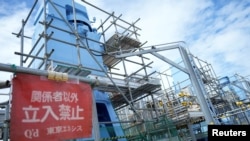More than a decade after a tsunami destroyed the Fukushima Daiichi Nuclear Power Station on Japan’s Pacific coast, the country has begun releasing the treated wastewater that has been accumulating on the site of the disaster, sparking anger in the region despite assurances by scientists that the process will not be harmful to the environment.
The water being released into the Pacific has been largely decontaminated of most dangerous elements, but contains small amounts of tritium, a radioactive isotope of hydrogen that cannot be extracted through any existing treatment method.
Water releases began in late August and will continue sporadically for decades as Japan works to reduce the amount of treated water on the site of the power plant. That water is currently stored in more than 800 tanks. Japanese officials say that it is necessary to drain and remove some of the tanks so that facilities necessary for the decommissioning of the plant can be built.
Japanese officials have gone to great lengths to demonstrate their confidence in the safety of the water surrounding Fukushima. Prime Minister Fumio Kishida appeared on television eating sashimi prepared from fish caught in the area after the water releases began.
Despite such displays, as well as assessments from experts, including the International Atomic Energy Agency, that the release of water will not cause harm to the environment, protests have arisen.
Japan and South Korea have been the sites of large demonstrations against the release. The Chinese government has been among the most vocal critics, accusing Japan of behaving irresponsibly and imposing a ban on the importation of Japanese seafood.
2011 disaster
The Fukushima power plant was devastated in 2011, after an earthquake off the coast of Japan generated a massive tidal wave that swept ashore on the east coast of Honshu Island, killing some 20,000 people and inundating entire cities. The wave disabled the systems that the plant used to keep nuclear fuel rods cool, resulting in a catastrophic meltdown of one of its reactors and the release of dangerous amounts of radiation.
The Japanese government was forced to evacuate tens of thousands of residents from the region and has been working ever since to mitigate the damage and prevent further contamination.
That process has involved an ongoing effort to keep the plant’s fuel rods cool, using seawater. The process causes the water to be contaminated by a number of radioactive elements. The water is retained on site and treated by what is known as the Advanced Liquid Processing System (ALPS), which removes almost all contaminants, with the exception of tritium.
Nuclear experts measure the amount of tritium present in a substance using units called becquerels. According to the World Health Organization, water containing up to 10,000 becquerels of tritium per liter is considered safe to drink. The treated water discharged from the Fukushima plant is being diluted to the point that it contains approximately 190 becquerels of tritium per liter.
Other countries release tritium
Japan is not the only country to release water containing tritium into oceans and rivers. Many nations that rely on nuclear power for some of their energy supply similarly release treated wastewater.
Despite its criticism of Japan’s actions at Fukushima, at least four Chinese nuclear power plants also release water containing tritium into the ocean, all of them at significantly greater concentrations than in Fukushima.
Over the length of the plan, Japan expects 22 trillion becquerels of tritium per year to be released. According to data released by the Japanese government, China’s Qinshan Phase III Nuclear Power Plant in Zhejiang province released 143 trillion becquerels of tritium in 2020. Last year, the report said, China’s Yangjiang Nuclear Power Station in Guangdong province released 121 trillion, while two other plants released 102 trillion and 90 trillion, respectively.
Other countries with nuclear power plants that release tritium include South Korea, France, Russia, Canada, the United Kingdom and the United States.
There is no clear evidence that tritium-containing water has caused environmental damage or posed a danger to humans or wildlife in the areas where it has been released, in some cases for decades.
China’s opposition
The Chinese government has taken a very public stand against the Fukushima water releases, despite engaging in the same practice itself.
A statement released by the Chinese Foreign Ministry said, in part, "The ocean is the common property of all humanity, and forcibly starting the discharge of Fukushima’s nuclear wastewater into the ocean is an extremely selfish and irresponsible act that ignores international public interests."
Criticism from Beijing has resulted in a concerted effort on the part of many Chinese citizens to bombard Japanese government agencies and businesses with abusive phone calls. In some cases, the near-constant barrage of calls has made it difficult for some businesses to conduct their normal operations.
Shihoko Goto, acting director of the Asia program at the Wilson Center, a Washington-based think tank, told VOA that China’s decision to focus so intently on the Fukushima water release is meant to demonstrate the significant "economic leverage" it has over Japan.
"It makes clear that Japan and the Japanese economy … [are] incredibly dependent on China," she said.
The controversy has also served as a distraction at a time when the Chinese economy is stumbling badly.
"That's been standard practice in China in the past. When things are going well, they don't necessarily see the need to lash out," she said. "But given the current circumstances, it's certainly a way for China to distract from the real issues."
Goto said it also demonstrates that "Chinese economic coercion is not going to be limited to small countries. It's also prepared to go against the world's third-largest economy."









